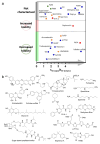Controlling amyloid formation of intrinsically disordered proteins and peptides: slowing down or speeding up?
- PMID: 35975807
- PMCID: PMC7617668
- DOI: 10.1042/EBC20220046
Controlling amyloid formation of intrinsically disordered proteins and peptides: slowing down or speeding up?
Abstract
The pathological assembly of intrinsically disordered proteins/peptides (IDPs) into amyloid fibrils is associated with a range of human pathologies, including neurodegeneration, metabolic diseases and systemic amyloidosis. These debilitating disorders affect hundreds of millions of people worldwide, and the number of people affected is increasing sharply. However, the discovery of therapeutic agents has been immensely challenging largely because of (i) the diverse number of aggregation pathways and the multi-conformational and transient nature of the related proteins or peptides and (ii) the under-development of experimental pipelines for the identification of disease-modifying molecules and their mode-of-action. Here, we describe current approaches used in the search for small-molecule modulators able to control or arrest amyloid formation commencing from IDPs and review recently reported accelerators and inhibitors of amyloid formation for this class of proteins. We compare their targets, mode-of-action and effects on amyloid-associated cytotoxicity. Recent successes in the control of IDP-associated amyloid formation using small molecules highlight exciting possibilities for future intervention in protein-misfolding diseases, despite the challenges of targeting these highly dynamic precursors of amyloid assembly.
Keywords: accelerator; amyloid; energy landscape; inhibitor; protein aggregation; small-molecule modulator.
© 2022 The Author(s). Published by Portland Press Limited on behalf of the Biochemical Society.
Conflict of interest statement
All authors declare they have no competing interests.
Figures




Similar articles
-
Insights into the Molecular Mechanisms of Alzheimer's and Parkinson's Diseases with Molecular Simulations: Understanding the Roles of Artificial and Pathological Missense Mutations in Intrinsically Disordered Proteins Related to Pathology.Int J Mol Sci. 2018 Jan 24;19(2):336. doi: 10.3390/ijms19020336. Int J Mol Sci. 2018. PMID: 29364151 Free PMC article. Review.
-
Cross-Linking Mass Spectrometry Analysis of Metastable Compact Structures in Intrinsically Disordered Proteins.Methods Mol Biol. 2023;2551:189-201. doi: 10.1007/978-1-0716-2597-2_13. Methods Mol Biol. 2023. PMID: 36310204
-
Formation of Heterotypic Amyloids: α-Synuclein in Co-Aggregation.Proteomics. 2018 Nov;18(21-22):e1800059. doi: 10.1002/pmic.201800059. Epub 2018 Oct 10. Proteomics. 2018. PMID: 30216674 Review.
-
A Fragment-Based Method of Creating Small-Molecule Libraries to Target the Aggregation of Intrinsically Disordered Proteins.ACS Comb Sci. 2016 Mar 14;18(3):144-53. doi: 10.1021/acscombsci.5b00129. Epub 2016 Feb 29. ACS Comb Sci. 2016. PMID: 26923286
-
From Disorder to Mis-Order: Structural Aspects of Pathogenic Oligomerization in Conformational Diseases.Protein Pept Lett. 2017;24(4):307-314. doi: 10.2174/0929866524666170220111930. Protein Pept Lett. 2017. PMID: 28219316 Review.
Cited by
-
Kinetic Steering of Amyloid Formation and Polymorphism by Canagliflozin, a Type-2 Diabetes Drug.J Am Chem Soc. 2025 Apr 9;147(14):11859-11878. doi: 10.1021/jacs.4c16743. Epub 2025 Feb 21. J Am Chem Soc. 2025. PMID: 39985130 Free PMC article.
References
-
- Iadanza MG, Jackson MP, Hewitt EW, Ranson NA, Radford SE. A new era for understanding amyloid structures and disease. Nat Rev Mol Cell Biol. 2018;19:755–73. - PubMed
-
- Knowles TPJ, Vendruscolo M, Dobson CM. The amyloid state and its association with protein misfolding diseases. Nat Rev Mol Cell Biol. 2014;15:384–96. - PubMed
-
- Gallardo R, Ranson NA, Radford SE. Amyloid structures: much more than just a cross-β fold. Curr Opin Struct Biol. 2020;60:7–16. - PubMed
-
- Tanzi RE, Bertram L. Twenty years of the Alzheimer’s disease amyloid hypothesis: a genetic perspective. Cell. 2005;120:545–55. - PubMed
Publication types
MeSH terms
Substances
Grants and funding
LinkOut - more resources
Full Text Sources

